|
|
German Binoculars page 6 pages: (1) (2) (3) (4) (5) (6) (7) (8) (8a)
Schutz Kassel Model - Soclar 15 x 56-1950 D.F. 18 x 50 CZJ -1916 Telarem 18 x 50 CZJ - 1936 CZJ 7 x 50 Binoctar
|
|
|
|
|
|
|
|
Schutz Kassel Model - Soclar 15 x 56 -1950s
The binocular - 15 x 56 manufactured in 1950s by Schutz Ruf & Co - earlier "Optische Werke A.-G. Cassel Carl Schutz & Co”.
The Company was produced binoculars in Kassel from about 1904 (or earlier) - 1960.
In March 8; 1904 Ferdinad Putz (or Puetz?) of Optische Werke A.-G. Cassel Carl Schutz & Co, submitted an application for a patent: “a design for a prismatic binocular using a combination of prisms that give a straight through effect”. The case was numbered - 1904/5727.
In October 23; 1906 Ferdinad Putz of Optische Werke A.-G. Cassel Carl Schutz & Co, submitted another application for a patent for “a design for a binocular based on the prisms shown in the Patent 1904/5727”. The source of information:
http://home.europa.com/~telscope/Ross/British.patents.telescopes.&.binoculars.pdf
These binocular of this design, were sold in the USA and the UK, under the name “Lumex”. In the Europe these kind of the binoculars were produced under other names: C.F. Foth & Co, Berlin; Aitchison & Co Makers, London & Leeds, in a time ca 1910.
The Company as “Carl Schutz & Co Optische Werke A.- G. Cassel” was produced three “Armee Modell” binoculars, with Porro II prism system and with 6, 8 or 10 power. All of them are described and pictured in the “gray” book of Dr Hans T. Seeger, page 116.
It is difficult to say when the Company merged with Ruf & Co factory. In “ Liste der Fertigungskennzeichen für Waffen, Munition und Gerät (Nach Buchstabengruppen geordnet) Berlin 1944 Gedruck im Oberkommando des Heeres” - the list of war time codes; is specified:
“Ruf & Co., Nachfolger der Optischen Werke vorm. Carl Schutz & Co., Kassel” -Ruf & Co., successors to the optical works formerly Carl Schutz & Co., Kassel (translated by Christopher Rozek). The Company received, in July 194,1 the war code as - gkp
Soclar 15 x 56
The Soclar models with objectives x 56, were built up with 8, 10, 15 and 20 power. Field of view in linear at a distance of 1000 yards - 60 yards. Diameter of exit pupil is 3,73 mm.
External features
It is central focusing model. The binocular body is built from aluminium with black textured leatherette. The prism house is rounded, as in all Schutz Kassel models. The objective tubes are very long - 142 mm ( 5.59 in). The prism house is 65 mm (2.55 in).
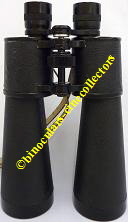 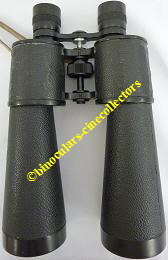
The Schutz Kassel Model - Soclar 15 x56 in our collection; Copyrights pictures Anna Vacani
The right ocular can be focused from - 3 to + 3 diopter.
The description and logo on the plates are written into the shape of a prism.
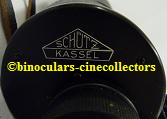 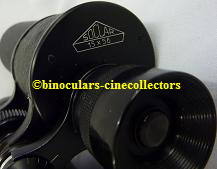
The Company’s logo is short with only two words. Earlier the Company produced binoculars with the logo extended for “Ruf & Co Kassel” in the bottom line - Models as: “Uranos”, “Heliolith”.
The binocular dimensions are: Width (fully extended) over the prism house - 145 mm (5.70 in) and underneath of the objectives - 175 mm (6.88 in) Weight 800 g (28 oz);
Internal features
It is Porro II prism system. The eye lenses and objectives are bloomed, but the prisms are uncoated. The rounded prism housing are closed up, the prism unit is firmly connected with the lower plate, which can be taken out during the disassembly downward. The prisms are not cemented. In this model between the two prisms is a black paper circular mask.
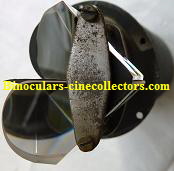 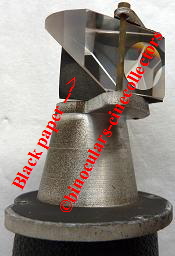 
The system prism in our binocular; Copyrights pictures Anna Vacani
The binocular does not have eccentric adjustment, in this way it is difficult to adjust. The collimation can be done only by loosening the screws of the metal plates, holding the prisms. Then, to set the collimation, the prisms must be move respectively.
The eye lens is small with 5 mm diameter.
Other information
The binocular has a lather case.
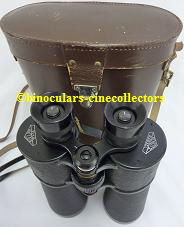
The Schutz Kassel Model - Soclar 15 x56 with the case, in our collection; © Copyrights pictures Anna Vacani
Production number: 97689 The number is placed under the central focusing left bar.
|
|
|
|
|
|
|
|
Carl Zeiss Jena - DF 18 x 50 - 1916
External features
Internal features
Other information
We are presenting another old binocular in our collection - D.F. 18 x produced by Carl Zeiss Jena. A few words about this model and its origins and evolutions.
The binocular - D.F. 18 x and later Delfort 18 x 50 models were manufactured from 1911 to 1930. The first model D.F. 18 x had a built-in optical system Porro I. The Porro I binocular and monocular models were produced from 1911. Approximately Carl Zeiss produced about 300 pieces of binoculars and monoculars, with the optical system Porro I.
The model D.F.18x was produced in three military versions:
- The first model “Tersex”, as Porro I, was manufactured up to 1915. The prism house of this model was much larger than later model “D. F. 18x”, and contained two Porro prisms per side.
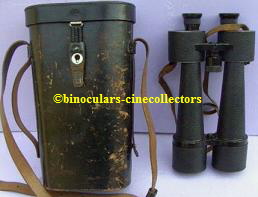 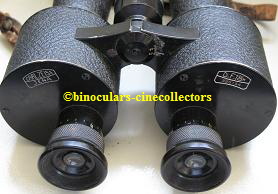
D.F. 18x; Production No 335134, with original case from Thomas Antoniades collection; Pictures © Thomas Antoniades
- The second military model of the D.F.18x, with new optical system Porro II, was produced from 1914 to 1918.
- “DF 18 x 50” it was the third military model.
The 18 x 50 military models, from this binocular group, were differently described throughout the production time. At the first period of manufacturing the binocular was marked “DF 18x” only (Picture 9). At a later term it was indicated as “DF 18 x 50” with engraved objective diameter measurement as well. The second and third military models had identical optical specification.
After the first war the binocular was named “Delfort 18 x 50” and produced for the civilian market. The optical design was the same as the military models. The civilian model price, in October 1928, was $120, listed in the Carl Zeiss catalogue.
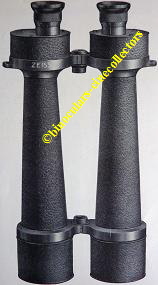 Picture from “Zeiss Field Glasses” Catalogue T 380 E, published in 1928 Picture from “Zeiss Field Glasses” Catalogue T 380 E, published in 1928
In 1930 binocular Delfort 18 x 50 was replaced by Telar 18 x 50 model (described in the next section with Telarem binocular).
Description of our binocular D. F. 18x
Our binocular D.F. 18x was produced in 1916, according to the list of the production numbers of D.F. 18x, and Delfort 18 x 50 models, researched for years by Thomas Antoniades.
The table of the D.F. 18x 50 and Delfort 18 x 50 binoculars production numbers, by Thomas Antoniades
|
Year
|
The first recorded
number
|
The last recorded
number
|
Notes
|
|
Model D. F. 18 x 50 binocular - Porro I
|
|
1911
|
238005
|
|
Monocular
|
|
1912
|
309987
|
309988
|
|
|
1913
|
335134
|
366957
|
|
|
Approximately 300 Porro I were made
|
|
1914
|
407187
|
431429
|
Porro II
|
|
1915
|
|
|
|
|
1916
|
591915
|
658177
|
|
|
1917
|
711702
|
796605
|
|
|
1918
|
862472
|
|
|
|
Approximately 1,900 Porro II DF 18x were made
|
|
Model Delfort 18 x 50 binocular- Porro II
|
|
1920
|
1066808
|
1099819
|
|
|
1921
|
1113358
|
1128300
|
Including monoculars
|
|
1922
|
1156991
|
1170159
|
Including monoculars
|
|
1923
|
1212135
|
1212196
|
|
|
1924
|
1228900
|
1244187
|
|
|
1925
|
1271456
|
1289078
|
|
|
1926
|
1332509
|
1332588
|
|
|
1927
|
1371557
|
1386671
|
|
|
1928
|
1415830
|
1437614
|
|
|
1929
|
1497617
|
1497862
|
|
|
1930
|
1522451
|
|
Monocular
|
|
Approximately 3,100 were made including about 100 monoculars
|
|
Thomas Antoniades announces: “The numbers shown above are those of recorded examples and not the range of production batches.
Our model was built for military use, with Porro II optic system.
The optic particulars of D.F. 18x are:
- The diameter of exit pupil is 2,8 mm. - The light transmitting power is 7.84; - Field of view in angular measure is 2,8Ëšand in linear at a distance of 1000 yds. is 49 yds.
The collectors say about the binocular performers: “Excellent image quality with a very impressive sharpness”.
1. External features
The binocular body is built from aluminium with black leather covering. Our binocular does not have an original covering on the main part of the body. The description on the right plate contains only “D.F.18x” without diameter of the objective, and production number.(Picture 8)
The sun shade over the objective is sliding very easy. The body tube that the sunshade moves on originally is black enameled painted, our binocular was repainted, by previous owner.(Picture 4)
The binoculars are designed in the shape of a telescope. In the Carl Zeiss Catalogue the binocular is is described as “field glass resembles already in its form our binocular view telescopes”.
The binocular can be fitted on a tripod with a tripod adapter. The original tripod in the pictures below:
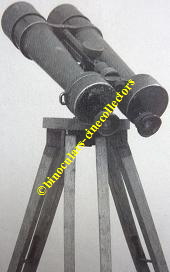 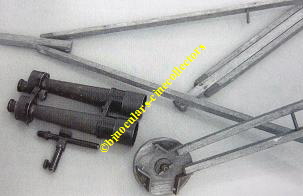 D.F. 18x; Pictures from Dr Hans T. Seeger book (gray) page 160 D.F. 18x; Pictures from Dr Hans T. Seeger book (gray) page 160
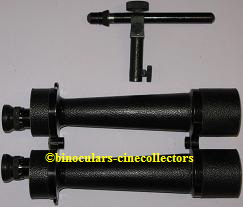 Delfort 18x 50 & adaptor; from Thomas Antoniades collection; Pictures © Thomas Antoniades Delfort 18x 50 & adaptor; from Thomas Antoniades collection; Pictures © Thomas Antoniades
There are different sizes of the adapters to the models 18 x 50. The bending bar tripod adapter of the early model binocular “Tersex” will not fit the Porro II D.F. 18x or ‘Delfort’ because the length is different to each model.
The adapter has a telescopic tube. When the tube is retracted it will clip into the top and the bottom indentations of the binocular.
The military D.F. model has an adjustable knob under the top bending bars to adjust the tension on the bending bars. (Pictures 3 & 4)
The military model has an attachment for the rain guard, which is fitted on above the top tension knob. (Picture 6)
The binocular dimensions are:
Width (fully extended) over the prism house - 145 mm (5.70 in) and underneath of the objectives - 145 mm (5.70 in) Weight 1340 g (2.95 lb); height 290 mm (11,42 in).
2. Internal features
The binocular has a very good light transmission. The secret of the high light transmission of this uncoated binocular is, that it has a small cemented Porro II prism and thin thickness of the eye lenses (Picture 1). In other words ‘a little glass for the light to pass trough’.
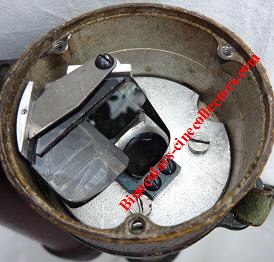 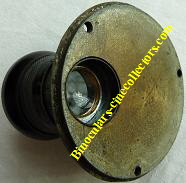
Picture 1; D.F. 18x the prism © Anna Vacani Picture 2; D.F. 18x the ocular © Anna Vacani
The objective often needs re-cementing. I has to be examine at outside of the eye lenses to see if they are scratch. It can effects the quality of the vision.
3. Other information
The binocular has a leather case. The case, visible in the picture is very well done, but it is not original case for D.F. 18x.
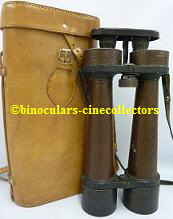 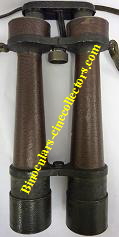 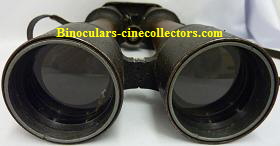 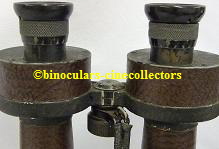
Picture 3© Anna Vacani Picture 4© Anna Vacani Picture 5© Anna Vacani Picture 6 © Anna Vacani
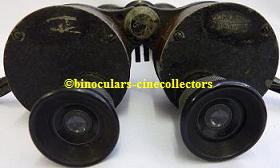 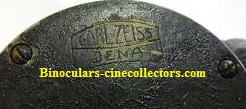 
Picture 7 © Anna Vacani Picture 8; the left plate © Anna Vacani Picture 9; the right plate © Anna Vacani
Production number: 634887 |
|
|
|
|
|
|
|
Carl Zeiss Jena - Telarem 18 x 50 - 1936
This binocular - ‘Telarem’ 18 x 50, in our collection, was manufactured, by Carl Zeiss Jena, from 1936. It is the central focus model. (Picture 1 & 2)
The “Zeiss Field Glasses” catalogue issue ‘T 500 e’, published in VI 1931, (in our collection) has an ‘Inset to issue T 500 e’ - printed in XII 1936. In this leaflet is posted information that the binocular ‘Telarem’ replaced the model ‘Telar’. The ‘Telar’ binocular was produced from 1930. The “Telar” was an eye focus model. The optical specification of “Telar” and “Telarem” was the same.

“Zeiss Field Glasses” Catalogue T 500 E, leaflet printed in XII 1936
This catalogue was supplied for some years, with additional stamps “No longer supplied” on the items which were no longer produced.
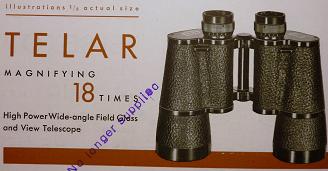 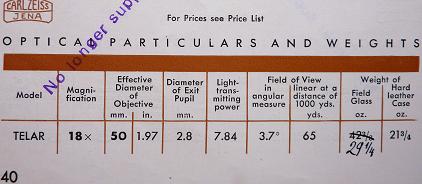
Pictures “Telar” binocular and optical description from “Zeiss Field Glasses” Catalogue T 500 E, published in 1931
The optics technical data of “Telarem” was not the same as in the binocular ‘Delfort’. The different is weight and field of view, because the binocular is shorter than model ‘Delfort’.
Here are two tables from Zeiss catalogues, published in 1928 and 1936:

Picture from “Zeiss Field Glasses” Catalogue T 500 E, published in 1931

Picture from “Zeiss Field Glasses” Catalogue T 380 E, published in 1928
External features
The binocular body is built from aluminium covered with black textured leatherette. The engraved description is filled with white emulsion.
The eye cups are designed differently than earlier 18 x 50 models. They have installed the additional rings on the eye cups, vertically knurled.
The binocular dimensions are:
Width (fully extended) over the prism house - 175 mm (6.88 in) and underneath of the objectives - 200 mm (7.87 in); height 165 mm (6,49 in); weight 883 gram (1,94 lb).
The production number is engraved on the washer (Pict 4)
The right ocular can be focused from - 3 to + 3 diopter. We can adjust the complete sharpness with the wheel mounted under eye bending bars.
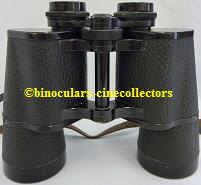 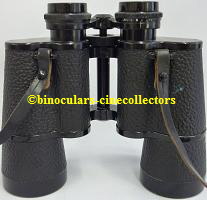 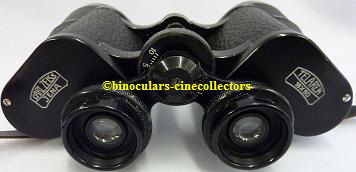
Picture 1© Anna Vacani Picture 2© Anna Vacani Picture 3© Anna Vacani
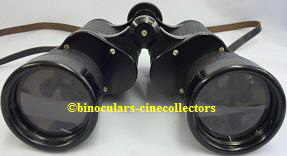
Picture 4© Anna Vacani
Internal features
The binocular is fitted with Porro I system. The optical system installed in the binocular is special. In whole optical system (between objective and eyepiece) is mounted the Barlow lens for magnifying the image. The Barlow lens was invented by Peter Barlow (1776-1862) - the English physicist and mathematician.
“The Barlow lens is simply a negative achromatic amplifier which works by intercepting the converging rays before they reach the focus, and, by refracting them ‘outwards’ produces a new focal plane at a greater distance from the objective.” - from the “Frank’s book of the telescope” by Charles Frank (the book in our collection).
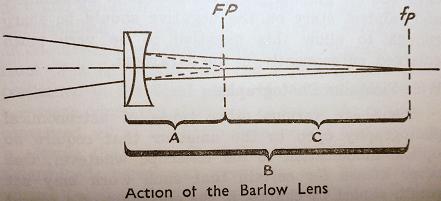
Picture from the “Frank’s book of the telescope” by Charles Frank; page 55
The arrangement of the optical system, in “Telarem” binocular consists: the objective lens, two Porro I prisms, one achromatic Barlow lens, eyepiece.
The “Telarem” binocular has a better field of view than the Delfort 18 x 50 models. However, the light transmission is not very good as the prisms and the Barlow lens takes light away.
Other information
The binocular has a leather case, presumably produced in Bath by C.C. Hansford. The name is embossed on the cover. (Pict 6)
We can suppose, that it was expensive case, because we bought the binocular in the case which was in the bag, sewn with fabric. The bag was sewn into the case. (Pict 5)
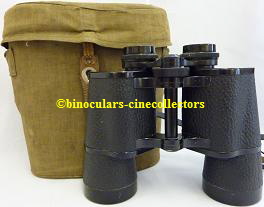 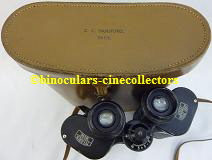
Picture 5© Anna Vacani Picture 6© Anna Vacani
Production number: 1728807
|
|
|
|
|
|
|
|
Carl Zeiss Jena 7 x 50 Binoctar - Production No 1567892
Introduction
A few words about early models 7 x 50
7 x 50 variant models
External features of our 7 x 50 Binoctar
Internal features
Other information
Bibliographic note
Introduction
The 7 x 50 models were used in Army and Navy divisions, in many countries.
As Dr John Gould British scientist and researcher in the publication ‘Binoculars for Surveillance Use’ says: “It has long since been known that 7 x 50s [...], and other binoculars of similar specification, with a large depth of focus, that very little focusing adjustment is really needed, either for distance or individuals. Hence it is quite possible and very desirable for both sealing and cost, to preset such binoculars to a standard focus to suit the majority of likely users.” Further description of the features of 7 x 50 as marine glass, you can read in the article “U-Boat binoculars”- Chapter IV.
The 7 x 50 models became very popular for their useful optical features. It was called as the “brightest “ binocular. In the Zeiss catalogue from 1950 we can read: “Its popularity is due to the large, bright overview image they present to the observer at dusk or on moonlit nights. „
We can see the illustration graph a visual performance of the 7x50 binocular, during twilight, it achieves 140%:
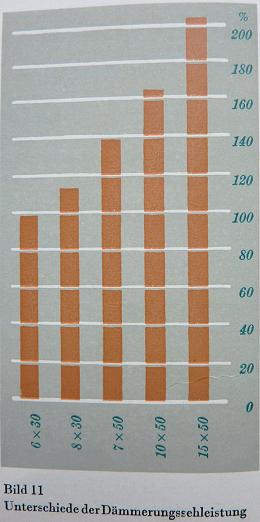
Pict 1; Carl Zeiss Jena Catalogue issued in 1950; in our collection; Illustration of differences in visual performance during Twilight (kindly translated by Christopher Rozek);
We can read further in the catalogue: “Therefore, they are preferred by all who wish to orient themselves in low light conditions quickly and securely, without having to put on an extremely strong magnification. That makes these glasses particularly valuable for hunting and seafaring.
Anyone who has ever watched a full moon as seen through the BINOCTAR or BINOCTEM the landscape unfolds a completely unexpected splendor, appreciate the benefits of this powerful light binoculars “
A few words about early models 7 x 50
The first 7x50 model was produced before the WWI. The first model, produced by Carl Zeiss, was Noctar 7x50 around 1912 to 1914, with an Abbe König prism system. The production of this model was finished ca 1922.
In 1913 Busch in Rathenow introduced the first model 7 x 50 with Porro I optical system.
Before WWI, in 1907, Leitz Wetzlar introduced the 7 x 50 model with Porro II system.
The best known model of 7 x 50 was Binoctar, manufactured by Carl Zeiss Jena. It was derived from 1914 -1915. This model was built in many variants, and became the standard Marine glass.
The 7 x 50 binoculars are visible in the photographs from the period of WWI and WWII, used on all kinds of boats; including submarines of WWI and WWII (see the article – “U-Boat binoculars”).
The most successful Nave binocular was produced in Carl Zeiss Jena, at the beginning of the WWI – D.F. 7 x 50. And later was produced as civilian model with individual focus ‘Binoctar’. This field glass was obtainable for 15 years, only with individual focus, with the purpose of using in the military and Navy.
The picture of D.F. 7 x50 produced during the WWI is placed in Dr Hans Seeger “gray” book, page 329.
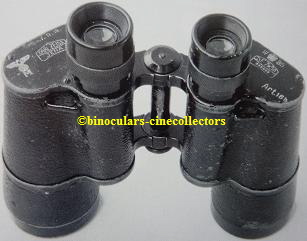
The binocular is described: “It is German Navy glass with engraving indicating of using of this model. It was taken into official use in Nov. 1918; Used in Austria as well in 1935.
Later used in the Kriegsmarine for artillery. It is heavy construction (1400 g) binocular, our weight is 1269g. Cover plates zinc, centre axis brass. One objective ring is zinc the other brass - an indication for the production at the end of WW I, where, due to the shortage of material, different parts had to be used. Leather covered and graticule in right-hand side, with vertical and horizontal graduation (cross hairs).”
In 1930/1931 was produced the model with central focus – named ‘Binoctem’.
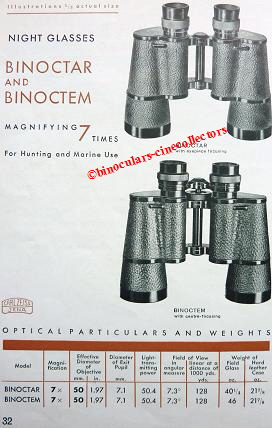
Pict 3; Carl Zeiss Jena Catalogue “Zeiss Field Glasses” T500 E, published in June 1931; in our collection
At the end of 1930s the lenses of the binoculars 7 x 50 manufactured by Leitz Wetzlar were coated. The coating increased the brightness of the image. It was important particularly for using on the boats. The coating binoculars were produced only for military.
Carl Zeiss Jena developed the lens coating in 1935/1936 as well.
The material, from which binoculars body, plates and rings were built, was changing over the years. The CZJ models were constructed from: aluminium, zinc and brass.
In time war time of 1917/1918 zinc was used for housing covers and the leather covering replaced the rubber. In the 30s aluminium became often used for all metal parts. In this way the binoculars become lighter. The leather and rubber covering were replaced with black paint.
After the WWII the Carl Zeiss Jena factory was on the territory of the DDR – Deutcher Democratic Republic. The production of the 7 x 50 Binoctar and Binoctem models was continued. The Binoctar model possible was manufacturing to 1991.
7 x 50 variant models
It was used for the design base of other 7 x 50 models: Gasmask (see – Unusual page 8); Kriegsmarine models; smooth barrel –water tight eyepiece (German binoculars – page 3, 7x 50 blc Kriegsmarine 1941, 1942 and 1943 and see – Unusual p.2), Scheinw u. u.Fluwa (searching and sound locator watch), Artl. (Artillery), Flak. Küste (coastal Flak).
The differences between some models were diameters of the lenses; a few has a big diameter, as Gasmask binoculars. Furthermore, Gasmask binoculars are different from 7 x 50 Binoctar on the eye piece which is four elements consisting of - two double cemented elements with the space between them. Both of these doublets are of the same focal length.
External features of our 7 x 50 Binoctar
In the CZJ catalogue published in April 1928 it was said: “It is accordingly much valued by those depending upon the use of a binocular in advanced dusk and even at night. Hence it is used by hunters at night, forest inspectors, navy officers, sea captains, etc. “
The diameter of exit pupil is 7, 1 mm. Light transmitting power – 50, 4. Field of view in angular measure is – 7, 3 Ëš, and linear at a distance of 1000 yards - 128 yards.
According to the list of production numbers our binocular was produced ca 1930. The binocular is in immaculate condition.
The main prism housing made of aluminium alloy and is covered by hard textured black leatherette. The top plates, objective rings, bending bar are made from brass. The bottom plates of the prism housing are made from zinc.
The oculars can be individually focused: graduation from - 5 to +5 diopter. The focus of the adjustment is fluted
The binocular description is a regular Zeiss design; it is written into the shape of the lenses; the name of the binocular and size on the right plate and logo of the Carl Zeiss Jena on the left plate.
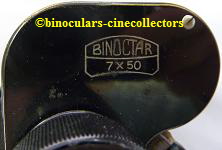
The binocular measurements:
Height – 170 mm (including eye tubes) 6 ¾ inch; Width – 200 mm (fully extended) 7 â…ž inch, Weight – 1183 grams (2, 60 pounds).
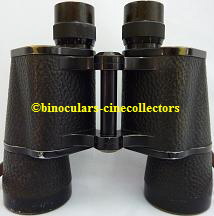 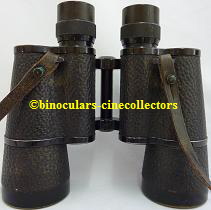 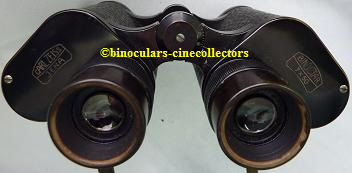
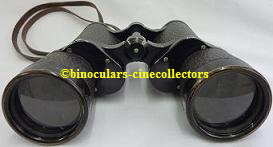
Pict 4; Carl Zeiss Jena 7 x 50 Binoctar, prod No 1567892 in our collection; ©picture Anna Vacani
The production number on the washer is showing the numbers very clearly.
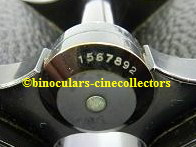
Pict 5; Carl Zeiss Jena 7 x 50 Binoctar, prod No 1567892 on the washer; ©picture Anna Vacani
In the price list of CZJ binoculars for October 1, 1928; in the CZJ catalogue 1928; Binoctar 7x50 is priced $ 90 and leather case $ 7, 50. Rain guard was produced for this model as well.
The binocular was sold with some accessories; rain guard (catalogue 1928 price -$1), Compass (with binocular - $3, 50, separately - $4, 50), Graticule (Mil scale including fitting - $7, 50).
Internal features
It is model with Porro I optical system. The eye lenses are small with 16 mm diameter. It consists of three lenses. The two of the top are cemented and one not cemented field lens. It has two Porro I prisms per side.
The objective achromatic glass is of two elements cemented.
The collimation adjustment is on eccentric rings on the objectives glass cell.
As the time of production, the optics is not coated.
Other information
Along the 7 x 50 Binoctar has been produced monocular version, named Binoctarmo. 
Pict 5; Carl Zeiss Jena Catalogue issued in 1950; Illustration of the monocular 7 x 50 Binoctarmo; page 28
In the CZJ catalogue published in 1928, the monocular was priced $43, 50. Weight – 500.842 grams (17 2/3 oz), the rest of the parameters are the same as the model 7 x 50 Binoctar.
7 x 50 models were used in US Navy. One of them is a specific model because of its description on the plate: Zeiss 7 x 50 US Navy Mark XXXV Mod.1
The specification is written into modified lens icon.
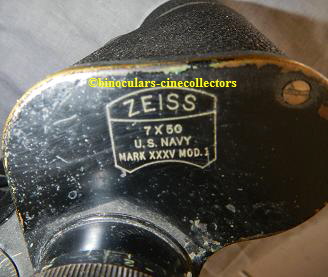 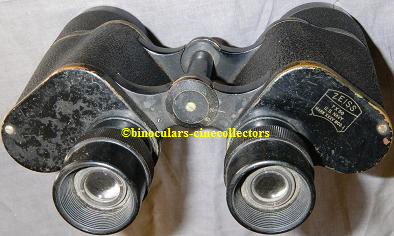
7 x 50 U.S. Navy model – Zeiss, in Dr Stephen Rohan collection; ©Dr Stephen Rohan
As Dr Stephen writes in his book “Military Binoculars”: “Zeiss, Jena converted to US Navy specification by National Instrument Corp., Houston, Texas. A contract was given to Zeiss for several thousand units in 1933. This binocular is a Carl Zeiss “Binoctar” model and has all the standard Zeiss features plus modification by National Instrument Corp., to US Naval specification”
This model was used in US Navy along side of the 7 x 50 Bausch & Lomb model, produced by Bausch & Lomb Optical CO., in Rochester, New York.
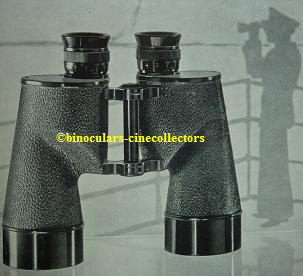
7 x50 Bausch & Lomb binocular; picture from the Catalogue – “Bausch & Lomb Life Long Binoculars” published in November 1935, in our collection.
The features of that binocular are similar to 7 x 50 Binoctar model, particularly with such excellent light gathering ability. In the catalogue it was announced that “the glass is dust and water tight”.
7 x 50 Bausch & Lomb binocular was sold in New York, Chicago, San Francisco, Los Angeles, Frankfurt a/M, and in London as well. In London, on 6th March 1937, the binocular was priced – 22, 0, 0 pounds.
Bibliographic note
The article was delivery on;
- Dr Hans Seeger –Militärische Ferngläser und Fernrohre in Heer, Luftwaffe und Marine; Military Binoculars and Telescope for Land, Air and Sea Service. Germany, Hamburg 1995; ISBN 3-00-000457-2.
- Dr. Stephen Rohan – A Guide to Handheld Military Binoculars 1894-1945;Published by Optical Press Bradbury,California,2001(ISBN 0-9709003-0-9)
- Carl Zeiss Catalogues published in 1928; 1931 and 1950
- Bausch & Lomb Life Long Binoculars published in November 1935
|
|
|
|
|
|
|
|
Page Back pages: (1) (2) (3) (4) (5) (6) (7) (8) (8a)
|
|
|